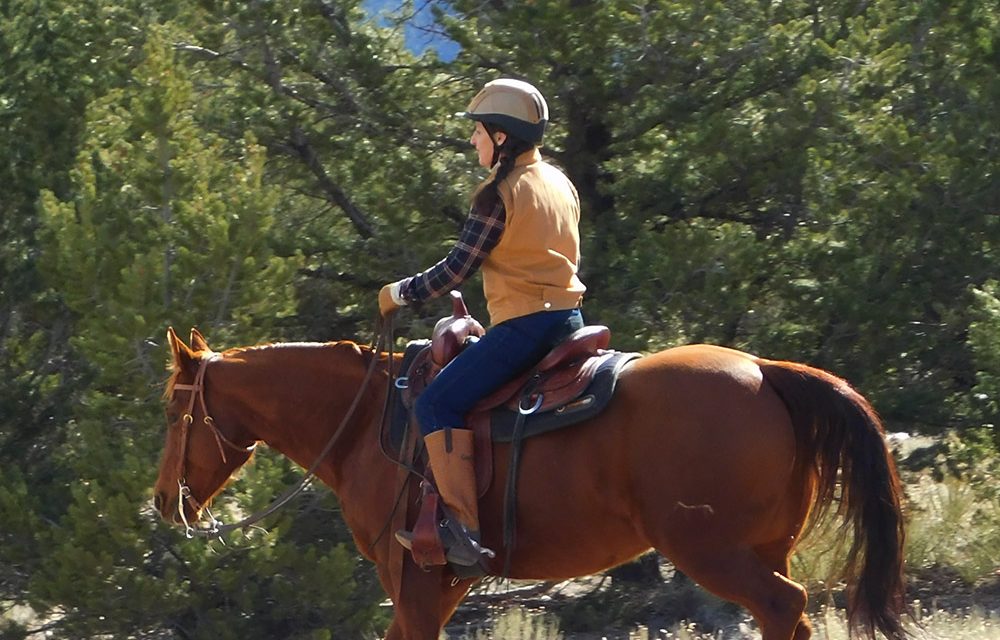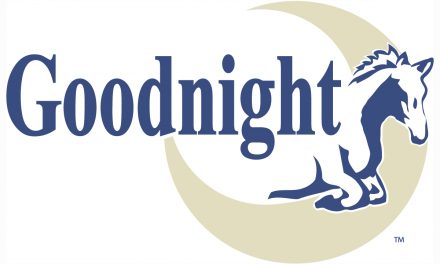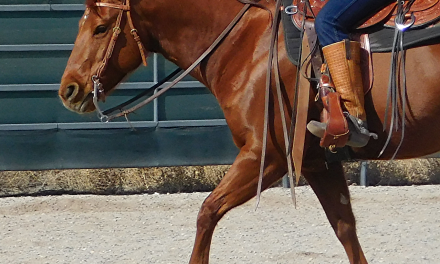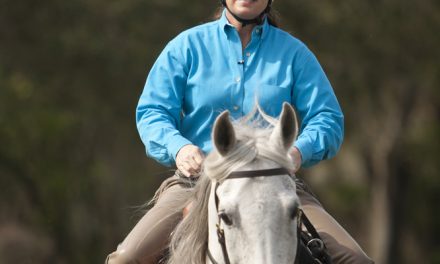 When was the last time you felt a lack of control while riding your horse, even if only for a moment? Was he spooked? Did your horse freak out because the other horses took off? During a tantrum your horse threw about leaving his herd mate?
When was the last time you felt a lack of control while riding your horse, even if only for a moment? Was he spooked? Did your horse freak out because the other horses took off? During a tantrum your horse threw about leaving his herd mate?
In the moment of panic—let’s say right after your horse spooked at a rabbit—most riders grab the reins and clench hard when they first feel a lack of control. Often, they fail to shorten the reins first, so the reins are too long, causing the rider to lean back, hands flailing and out of balance too. With white knuckles the rider clenches on the reins (inadvertently clenching with her legs too), as the horse dives into the bit, stiffening his neck, leaning on the rider. This scenario rarely pans out well for the rider.
Let’s look at this same scenario from the horse’s point of view (hPOV). I was going down the trail just fine, as commanded by my rider; I was obedient, my head down, no pressure on my mouth, and I was eating up the ground like a good trail horse. Out of nowhere, that evil rabbit jumps right at me! OMG! It coulda been a mountain lion! Suddenly my rider screams and grabs the reins, jerks my mouth, ouch! Now she’s scared, I’m scared and my mouth hurts! Rider keeps pulling even after I stopped, wrapping that jointed bit right around my tongue and jaw. Double ouch! I stiffen the muscles on both sides of my neck and lean on the bit to protect my mouth. Panicked, I do what I do best—run for home, running toward safety as if that bit wasn’t there.
There’s no doubt that being out of control on a fractious horse is a terrible feeling and the tendency to stop is huge. But with horses being flight animals, it usually works better to keep them moving, ride proactively and re-establish control through purposeful movement. Horses are also comfort animals, so rest (after hard work) becomes a huge reward. One of the oldest wisdoms of horsemanship (thousands of years old) is, “Forward motion is the basis of all training.” Without willing, free and forward movement, the horse cannot be trained.
Horses respond well to confidant authority. Horses are animals that are habitual in their behavior and remember their training, even though at times they may need a little reminder. Being a proactive, confident rider is what your horse needs and wants. If you are rider that tends to panic when you feel a loss of control, there’s a dynamic between you and your horse that needs to change—and you are the only one capable of introducing that change.
Here are my best three tips for how to become the confidant, proactive rider your horse needs.
#1 Stay present in the moment. Don’t allow your mind to shut down in panic; be observant of your surroundings (it’s your job as the leader, you know). Don’t start shutting down, grabbing the reins and thinking about all the things that could go wrong or have gone wrong before. Be aware of your horse and what he needs from you—it’s not his job to make you feel safe; it’s your job to make him feel secure. Take a deep breath (and many more). Keep your eyes active and aware, taking in information in your environment. Relax the reins. Ride the horse beneath—you not the one in your head. Don’t read things into the situation that aren’t there. Allow your horse to calm down; don’t’ keep him in an anxious state just because you’re anxious. Remember, he can calm down and become obedient just as quickly as he spooked, so let him.
#2 Think and ride through the situation, like you know how to do. Immediately start asking your horse to go somewhere and do something—trot, turn right, turn left– preferably using up some oxygen as you do (think working trot). It’s what your horse knows how to do (stop, go and turn) and it will get his mind back in the game faster. As soon as you start asking him to go somewhere, doing what he knows how to do, he feels a since of normalcy and starts relaxing. That’s your cue to relax and soften the reins, sit back and take a deep breath. Controlling forward movement is much easier than trying to staunch it. Moving forward relaxes a frightened horse and then, letting him stop and rest when he relaxes, rewards his relaxation and compliance. It’s a win-win.
#3 Ride with a destination in mind. Be purposeful—look where you are going and ride with determination. One of the first things that happens when a rider panics is that she looks down and loses all focus as her mind shuts down and she stops riding. Horses are masters at determining your level of determination and intent—they can see it or feel it in your body language and posture. When the rider shuts down, the horse learns he can do whatever he wants. Always look far past where you plan to go and ride like you have a plan; Look about 10 seconds ahead of your horse, seeing your specific route and focus on a destination. Your horse will feel your intent and respond accordingly. Don’t compromise; accept nothing less than 100% compliance. Once you have asked a horse to do something, you must follow through on the request. If you start a turn and then abandon that request because your horse didn’t respond, you just trained him to ignore your request to turn.
When you become a more proactive and confidant rider, the hPOV will change drastically:
I’m going down the trail like a good horse, the reins are slack, my head is down, and my rider is happy and I feel good. That evil rabbit jumped at me and I freaked at first, but right away, my rider rubbed my neck told me I was okay and she went right back to riding like nothing ever happened; I took a deep breath and we rode off toward something more important than that silly little rabbit. I feel safe with my human, she’s clearly in control of the entire universe and I know she will take diligent care of me; I’m just along for the ride.
Remember, all riders have moments of doubt, nerves or uncertainty. Riding a thousand-pound flight animal is no little thing. But it’s important to keep in mind that there is a living, breathing, thinking animal underneath you, who is going to respond to your actions, for better or for worse. Learning to keep your mind engaged and present in the moment—thinking through the situation and riding purposefully—will get you out of most sticky spots with your horse.
Enjoy the ride,
Julie Goodnight
Trainer and Clinician
###
—
About Julie Goodnight
Goodnight is the popular host and producer of Horse Master, a successful how-to TV series on handling, riding, and training horses, airing weekly on RFD-TV since 2008. Goodnight travels extensively sharing her no-nonsense horsemanship with riders of all disciplines. Goodnight is experienced with many kinds of riding– she grew up on the hunter-jumper circuits in Florida and is now at home in the West. She and her husband, Rich Moorhead, live in the mountains near Salida, Colorado, where they enjoy riding the trails and training cow-horses.
Explore Goodnight’s training library of articles, videos and more at JulieGoodnight.com/Academy. Find her on YouTube.com/juliegoodnight and follow @JulieGoodnight on Instagram and Twitter. Check out her full list of clinics and events at: JulieGoodnight.com/calendar.





